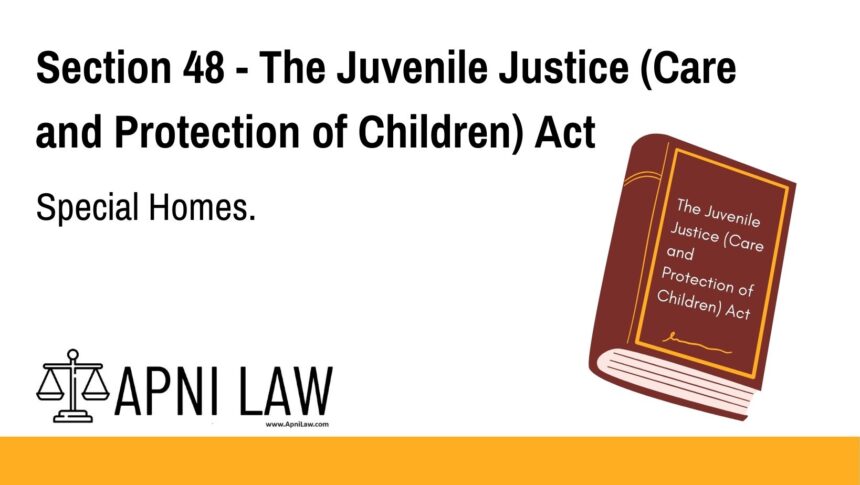Code: Section 48 — Special Homes
(1) The State Government may establish and maintain either by itself or through voluntary or non-governmental organisations, special homes, which shall be registered as such, in the manner as may be prescribed, in every district or a group of districts, as may be required for rehabilitation of those children in conflict with law who are found to have committed an offence and who are placed there by an order of the Juvenile Justice Board made under section 18.
(2) The State Government may, by rules, provide for the management and monitoring of special homes, including the standards and various types of services to be provided by them which are necessary for social re-integration of a child, and the circumstances under which, and the manner in which, the registration of a special home may be granted or withdrawn.
(3) The rules made under sub-section (2) may also provide for the segregation and separation of children found to be in conflict with law on the basis of age, gender, the nature of offence committed by them and the child’s mental and physical status.
Explanation of Section 48
Section 48 of the Juvenile Justice Act allows State Governments to set up and manage Special Homes. These facilities are specifically designed to house children who have been found guilty of committing an offence. Unlike observation homes, which are temporary, Special Homes serve the purpose of rehabilitation for a longer duration.
Children can be placed in Special Homes only by an order of the Juvenile Justice Board under Section 18 of the Act. These homes are aimed at reforming and reintegrating such children back into society. The law gives the State Government authority to establish these facilities directly or through partnerships with voluntary or non-governmental organizations.
Moreover, Section 48 outlines the need for proper management rules. These rules should ensure quality services, address the children’s needs, and include procedures for registration and oversight. Additionally, the children should be separated by age, gender, offence type, and physical or mental condition to provide the most suitable environment for their rehabilitation.
Illustration
Example: A Court-Ordered Placement
Pooja, a 16-year-old girl, is found guilty of committing a serious offence. The Juvenile Justice Board, after assessing her case under Section 18, directs that she be sent to a Special Home. The home, operated by an NGO registered with the State, provides her with therapy, vocational training, and counseling to help her return to mainstream society after her rehabilitation period.
Common Questions and Answers on Section 48
1. What is the difference between a Special Home and an Observation Home?
Observation Homes provide temporary shelter during inquiry. Special Homes are for children found guilty of an offence and focus on long-term rehabilitation.
2. Who can be sent to a Special Home?
Only children who have been declared to be in conflict with law and are ordered by the Juvenile Justice Board under Section 18 can be placed in a Special Home.
3. Can NGOs run Special Homes?
Yes. The State Government can authorize voluntary or non-governmental organizations to manage these homes, provided they follow prescribed rules.
4. Are boys and girls kept together in these homes?
No. Children are separated based on age, gender, offence type, and their mental and physical condition, as per the rules established under this Act.
5. How are Special Homes regulated?
The State Government issues rules for their management and monitoring. These rules ensure quality services, define operational standards, and outline conditions for registration and de-registration.
Conclusion
Section 48 plays a vital role in rehabilitating children who have been found guilty of legal offences. By mandating the creation of Special Homes, the Juvenile Justice Act ensures that such children receive proper care, guidance, and skills needed for re-entry into society. These homes help reduce repeat offences by focusing on social reintegration rather than punishment.
For more legal insights and updates on child protection laws, visit ApniLaw.








